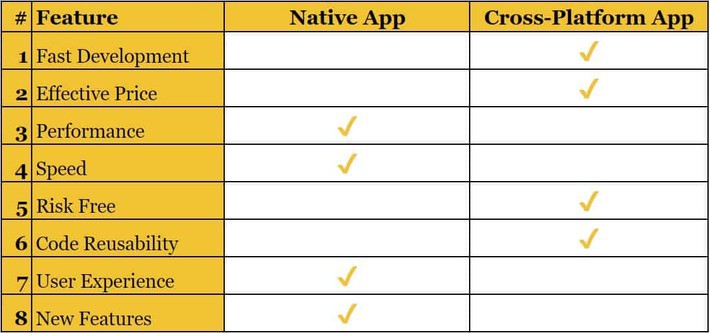
Native vs Cross-Platform Apps Development
Have you ever dreamed about presenting a mobile application that will boom the society: people will talk about it and use it with great pleasure, the app will meet users’ demands and requirements, you will be happy and feel useful. If this is still a dream then your high time has come to make this dream come true.
In this article, I’m going to help you choose the most suitable platform that best meets your objectives especially if we talk about business objectives.
So, if you emphasize the importance of mobile apps for businesses, and you are about to have your mobile application created then you have two options to choose between.
Probably, the development company you rely on will let you know about it. However, they may also guide you on whatever they offer. That’s the reason I’m going to introduce these two options so that you can understand the difference and make the right decision.
Your two choices of mobile app development are native app vs cross-platform. And you’ll learn the characteristics and peculiarities of both types of mobile development to clearly identify all the advantages and drawbacks you may face during the development process. And here we are.
Let’s start with native mobile app development.
Native App Development
Native application development refers to the creation of separate software programs to run on specific platforms and devices such as applications for desktops, any kind of gadgets, smart TVs, etc. However, smartphones are the target devices as they are always with people. Most of all, development companies focus on creating mobile apps for Apple’s iOS and Google’s Android operating systems.

Let’s go on and define some of the essential features of native mobile applications.
#1 Better Performance
Native applications directly interact with native APIs and don’t depend on other plugins. Imagine that in the development process, a point comes when different codes are written for each OS to deliver better performance for that specific system. Thanks to the fewer dependencies, native mobile applications run faster and are more responsive. These features are especially important for performance-centric apps such as games or graphic-heavy applications.
#2 Consistent Look and Feel
Native mobile applications are built using native Software Development Kits (SDK), thanks to which the UI of these apps looks consistent with the platform. Accordingly, a better UX is ensured as there is no disagreement between the application design and the operating system. Native apps are more interactive, intuitive, and more smoothly run in terms of user input and output.
#3 Accessibility to New Features
Another advantage of native development is that developers get access to the full set of features for a specific OS (iOs or Android). Yet, the cross-platform apps have to wait until there is an available plugin that supports new features.
#4 Better Compliance with Store Guidelines
Thanks to their architecture, native applications are provided with complete support from the overall app marketplaces. The distribution in app stores delivers easy discoverability.
 Native Android Development
Native Android Development
To build native Android applications developers use programming languages like Java, Kotlin, or C++. The great thing is that Google provides advanced in-house tools for Android development, including:
- Android SDK package with Android Studio (the official IDE (integrated development environment) for Android)
- Command-line tools for Windows, Mac, and Linux
- Firebase (a comprehensive platform for mobile development)
- Android Jetpack (a set of pre-made Android components)
Many third-party solutions are also delivered to use for Android development. Android apps may be developed both on personal computers and Macs. And whenever the native Android app is ready, you submit it to the Google Play Store from where potential users download or buy (in case of premium apps) it.
 Native iOS Development
Native iOS Development
Native iOS apps are created in Swift or Objective-C. The iOS operating system provides closed source code, specifically created for Apple’s hardware. A Mac device is required to develop native iOS mobile applications.
Apple also delivers many tools and resources for iOS development. Let’s get familiar with some of them:
- iOS SDK (integrated with the Cocoa Touch UI framework)
- XCode (this is the official IDE for iOS development)
- Swift Playgrounds (learning platform for Swift development)
- TestFlight (beta testing app)
iOS also offers a third-party ecosystem with popular development tools, including AppCode, and CodeRunner. On the other hand, the review guidelines are strict in the App Store. Your iOS app may be rejected for various reasons related to poor performance, security issues, or lack of valuable content.
However, native apps have some drawbacks as well. They are created using complex programming languages that require experienced developers. Costs are relatively higher and the development time is longer. Native apps are not recommended for simple applications. In such cases, cross-platform apps development is a better solution. Now let’s pass on this type of mobile application.
Cross-Platform App Development
Cross-platform app development aims at creating mobile applications that run on more than one OSs. Imagine, the code is written once, and the final product is possible to run anywhere. In this case, the focus is still on iOS and Android.

If you don’t know, the world-famous social media platform - Facebook built its application relying on cross-platform development. Once during a conference, Mark Zuckerberg - the co-founder of the company, said:
“The biggest mistake we’ve made as a company is betting on HTML5 over native.”
If you are interested in choosing the best mobile app development language or framework then read one of our previous articles. Now I’ll introduce some features of cross-platform apps below.
#1 Code Reusability
Unlike native development that pretends writing fresh code for every platform, cross-platform development allows reusing the same code across different platforms. This cuts down the number of repetitive tasks and throws out the tedious work.
#2 Development Cost
In the case of cross-platform mobile app development, companies invest once, and the product costs cheaper. There is no need to spend a huge budget on individual platforms separately. On the other hand, the cost decreased depending on the number of developers included in the team.
#3 Faster Release
The process of cross-platform mobile app development is implemented faster as a single script is deployed. Thanks to faster development time, your application appears in the marketplace sooner and users may install it in their devices.
#4 Easy Integration with Clouds
Cross-platform mobile applications are fully consistent and can take advantage of multiple plugins integrated with cloud settings. To speak in a simpler language, one single source code is matched with many plug-ins and extensions. As a result, the scalability and functionality of the application are improved.
In regard to performance challenges, cross-platform apps lack. They face integration challenges with the target OS. This is because of the uncertain relationship between the native and non-native components of the device. This is a drawback that affects the optimum performance of the app.
Native vs Cross-Platform Apps Development

Final Words
From all the above-mentioned features we come to the conclusion that both native and cross-platform applications have their pros and cons. However, if you want to know my opinion, I recommend cross-platform development. You get an application that is run on various systems at a lower price in the shortest possible time. And yet there is a low level of risk. Even if your app doesn’t work properly and satisfies you, your loss isn’t as great as it would be in the case of native development.
And if you still worry about the drawbacks, stop for a moment and think how successful cross-platform apps like Facebook, Instagram, Skype, Pinterest, Uber, etc. are. Even if there are some drawbacks, they aren’t obvious especially for ordinary users.
In the end, I just want to let you know that the developers’ team at AIST is always ready to listen to your ideas and offer the best possible solutions on making them come true.

Автор։
Vera Mirzoyan
Опубликована։
Май 27, 2020
Последное обновление։
Сентябрь 02, 2021


